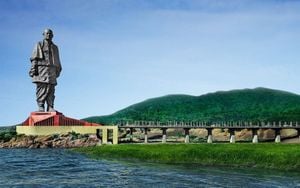Afghanistan has once again felt the shudders of seismic activity, reminding residents of the region's turbulent geological history. On October 31, 2024, at 06:21 UTC, the earth shook with a magnitude of 4.1 just 26 kilometers northwest of Rustāq, Takhar, Afghanistan. This earthquake struck deeply within the mountainous terrains, where tectonic plates regularly clash, leading to frequent quakes. Fortunately, initial reports showed no immediate damages or casualties, sparking relief among local authorities.
The earthquake's location at 37.33°N latitude and 69.68°E longitude placed it within the historical seismic prone zones of Afghanistan. For the inhabitants of this region, recent seismic events have become almost routine. Takhar province, notorious for its rocky landscapes and high-altitude villages, often experiences seismic tremors due to its positioning at the edge of several tectonic boundaries.
On the very next day, November 1, 2024, another quake struck the same region, this time with slightly less intensity at 4.0 magnitude, reported 98 kilometers south of Faizabad, the capital of Badakhshan, at 01:16 AM GMT. This quake again highlighted the region’s instability. The geographic coordinates for this tremor were 36.29°N and 70.96°E, adding to the narrative of geological unrest within the country.
To track these seismic activities, geologists worldwide rely on data from various monitoring agencies. For example, the earthquake on October 31 was documented using real-time data from the National Seismic Center and various global networks which monitor seismic activities 24/7. These resources are pivotal for quickly assessing the magnitude and effects of each quake.
One notable detail about these quakes is their frequency. Scientific data indicate Afghanistan experiences several tremors monthly, many of which go unreported or unnoticed by the population due to their low magnitudes. Yet, the fear remains among residents; each quake, no matter the size, is accompanied by whispers of potential disaster.
On the same day as the 4.1 magnitude quake, residents reported feeling lighter shakes across neighboring countries like Tajikistan, hinting at the interconnectedness of seismic activities across borders. Residents near the border shared experiences on social platforms, expressing their concerns over the tremors. Communities engage actively during these times, coming together to share information, reinforcing their resilience against nature's unpredictable temperament.
Beyond Takhar and Badakhshan, seismic activity has also affected regions as far as parts of Pakistan. A more recent 4.5 magnitude earthquake occurred east of Faizabad at 07:09 AM GMT on November 1, demonstrating the extensive reach seismic waves can have across this rugged terrain. Responsibilities of responding to these tremors often fall to local authorities who must assess the needs of affected communities swiftly.
The mountainous geography, which makes Afghanistan so picturesque, also makes it incredibly vulnerable to natural disasters like earthquakes. Geological features such as fault lines running through Central Asia contribute to the precarious seismic situation. Experts stress the importance of disaster preparedness and community education to mitigate the risks associated with these unavoidable geological phenomena.
Organizations dedicated to disaster response have been scaling up efforts to educate local communities on what to do before, during, and after earthquakes. Encouragements for households to develop emergency plans and stock up on supplies reflect the proactive approach needed to address these challenges effectively.
With each quake, whether it’s felt strongly or barely noticeable, it acts as yet another reminder of the need for both awareness and preparedness. For Afghan residents, the hope lies not only within the stability of their own homes but also within the collective strength of their communities. Collaborative efforts among government agencies, disaster response organizations, and citizens can pave the way for enhanced safety and resilience against the ever-present threat of earthquakes.
The situation over the next few days and weeks will be closely monitored by geologists and government bodies alike, keeping watch on the possibility of aftershocks and determining the broader impact of these seismic events. Each occurrence plays its part, shaping the geological narrative of Afghanistan and refining the lessons learned for future preparedness.



